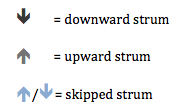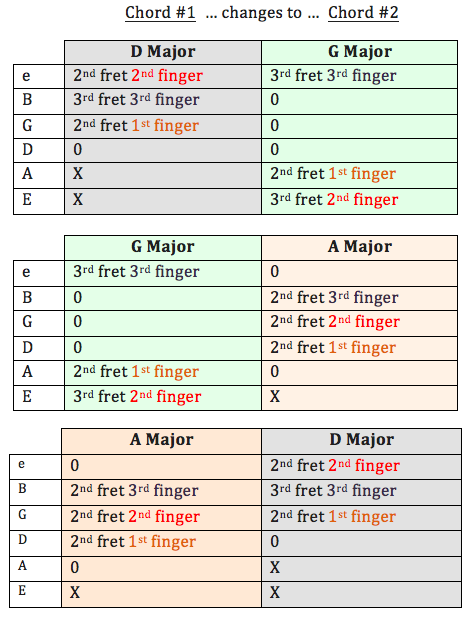Welcome to Part Three of Your First Song, a four-part series made especially for beginner guitarists.
In Pt 2: How to Strum a Guitar, we used one of the three chords from Pt 1: Easy Guitar Chords to play the basic strumming pattern for ‘Twist and Shout’ by The Beatles. Now that we’ve got the rhythm of this pattern down, let’s learn about changing chords.
Changing Chords
Just as important as learning each chord is being able to transition well between them. For ‘Twist and Shout’, we only need three chord changes:
The goal is to be able to change chords while staying in rhythm with the strumming pattern – that is to say, without losing the beat. To become good at this, there really isn’t any shortcut; the best way is to just do it. But we can simplify: the easiest way is to go string-by-string, finger-by-finger.
‘The easiest way is to go string-by-string, finger-by-finger.’
Here’s the breakdown for each chord change by string:
Note that these diagrams show the lowest-pitched (thickest) string on the bottom and the highest on top, as with guitar tablature. That means you will need to turn these upside-down in your head when playing them.
To help you go through these chord changes, here is a quick exercise you can do in just five minutes:
5-Minute Chord Change Exercise
- Pick a chord, any chord – let’s start with D major
- Get your fingers in the right positions and strum the chord
- Look at each finger and notice where it will have to move for chord #2 (look at the chart)
- Move your fingers to their positions for chord #2
- Repeat steps 3 and 4, but reverse the order of the chords (change from chord #2 to chord #1)
- Repeat all steps a total of five times to complete the exercise
‘The more times you do each chord change, the less you will have to think about it.’
I know it’s a bit cumbersome at first, thinking through the different chords, strings, frets, and finger positions … it’s enough to give any newbie a headache! But the more times you do each chord change, the less you will have to think about it.
Putting It All Together
After you’ve gained some confidence with the three chord changes, the last step is to combine it with the strumming pattern we learned last week in Part Two (pictured below). Dial in your metronome at 126 bpm (or whatever speed is most comfortable) and let’s start strummin’! Here’s how it goes:
*When playing ‘Twist & Shout’, you 
A Few Helpful Tips:
- Finger positions on chord diagrams are only suggestions. If you find a finger position that’s more comfortable for you, go ahead and use it (e.g. I sometimes use my 4th finger instead of my 3rd on the high e-string of a G major chord).
- When changing chords, it’s OK to let go of the fretboard for a second during the transition. Sometimes it’s easier to just let go with your fingers before finding their new positions.
- Just as with learning the strumming pattern or the chords themselves before that, remember to slow it down. There’s no rush here.
Good job – you just learned how to play the verse of ‘Twist & Shout’! Keep practicing the strumming pattern with the chord changes and you’ll be playing all of ‘Twist & Shout’ in no time!
Worried about singing while playing the guitar? Help’s on the way! Check back in next Monday for more tips on how to play.

Cody is a professional singer, songwriter, performer, and recording artist. His instruments include bass, trumpet, drums, harmonica, piano, and most especially guitar. In his spare time he travels, brands businesses, and makes lists of his many accomplishments.
Cody is a student at the University of Utah under his own self-created degree, Music Business and Technology, and recently returned from four months living in Kathmandu, Nepal providing humanitarian aid to the victims of the recent earthquake.
Watch the music video for ‘Batti Ayo’, Cody’s tribute to the Nepal quake victims, at codyrobinsonmusic.com
Or follow him on Instagram: @codyculture








